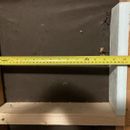Fill in Extra Space Between Studs with XPS?
Good Day,
Short version:
Is it okay to line my studs with XPS foam to fill-in the space so rockwool batts to fit properly? I’m concerned about causing moisture issues with the framing if I do so.
Long version/context:
I’ve been renovating my home. As part of my renovations, I’m redoing my exterior insulation, including 16″ R13 Rockwool Batts (15.25″ actual width) going in the stud cavity. I’m using Pro Clima’s Intello as my vapour control layer.
The house is very old and not built well by modern standards. My latest predicament is that the framing isn’t quite 16″oc. Stud spacing is anywhere from 17″ to 18″oc, leaving me with (on average) 16″ gaps between studs. This is causing issues with the batts, as they are 1/2″ to 1″ too narrow for the space. Generally they just flop out, and even when they don’t, having that much of an air gap is unacceptable.
At first I tried cutting a batt into narrow strips to fill it in, but that is incredibly tedious. Something I considered, if sticking solely with rockwool, was to order a couple bags of 1″ thick Comfortboard, rip them into 3.5″ strips, and use them to fill the gap. However, this second option would cause downtime. Instead, my third option is to use XPS in the same way. I already have a sufficient amount of XPS foam, in various thicknesses, kicking around (from an interior insulation/vapour barrier scheme that Randy Williams talked me out of).
From an insulation standpoint, I don’t think I’m losing anything by lining the studs with XPS. Better R value per inch than the Rockwool, very easy to work with, etc. However my concern, as stated above, is about trapping moisture against/within the individual studs of my framing. Will the XPS cause issues trapping moisture within the framing; or, will moisture still be able to move through the wood to the inside/outside edge sufficiently to prevent issues?
I have attached a photo as an example of the stud spacing I am working with, and the solution as proposed. For this particular cavity, I would put a 1/2″ layer of XPS on the face of the left stud in addition to the 1″ piece of foam on the right stud. This would bring the space in the cavity down to 14.75″, which should be sufficiently tight for the Rockwool batts to then hold themselves in place as intended.
If anyone has thoughts/concerns about this idea that I haven’t brought up, I’d love to hear them.
Thank you for your time,
Matthew B
GBA Detail Library
A collection of one thousand construction details organized by climate and house part










Replies
I don't see any downside to what you propose doing. The issue that usually comes up with rigid foam in stud bays, besides the labor of cutting the foam to fit, is that it's difficult to seal it reliably so that you don't have moisture issues down the road. In your case, you're using the rigid foam as a sort of shim, not an insulating panel across the entire stud bay, so you won't have any added moisture risk from the rigid foam, and no need to seal the rigid foam.
What I would do here though is just cut the mineral wool batts to fit "sideways". Instead of cutting narrow strips, which is difficult to do well, turn the batt on it's side, and cut it to fit horizontally instead of vertically. This gives you a bunch of pieces the length you need to fit between the studs, all 15.25" high. You put a bunch of those "stacked" into the oversized stud bays to fill the wall. This is what I usually do, but I usually only have a few oversized studbays to deal with. If your entire wall needs to be insulated this way, then you need to determine if it's more labor to go with the rigid foam strips or the cut batts. I would then go with whichever was a faster/easier method of installing the insulation.
BTW, if you have a hot knife cutter, I'd use EPS here to save money, since it's still higher R per inch than mineral wool. The only advantage XPS has here is that you can score and snap it, although that doesn't always work well for narrow strips like you'll need here. Either material is very messy to try to cut with any kind of saw.
Bill
Hi Bill,
I read your reply, and took the time to try both methods on a couple cavities. I found that they took about the same amount of time. While I found the mess from ripping XPS on the table saw wasn’t bad, I would agree the cost is quite high. I wouldn’t have considered going this route if I didn’t already have the XPS laying around and had no other use for it.
Thanks for taking the time to reply and put my concerns to rest.
Matthew B